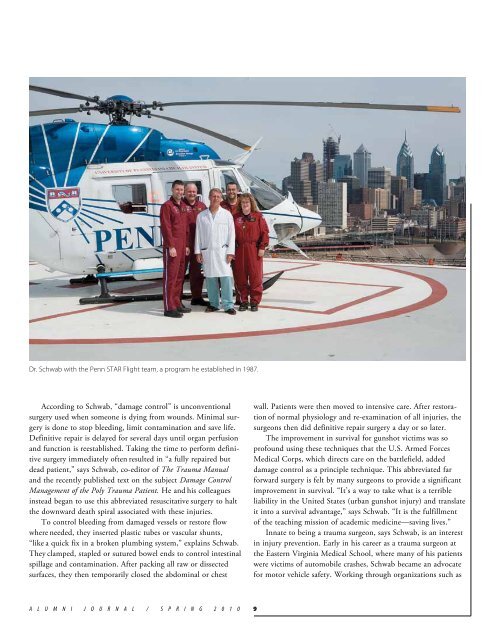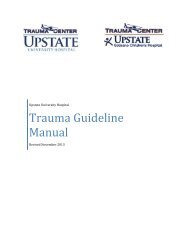10 Alumni Journal - SUNY Upstate Medical University
10 Alumni Journal - SUNY Upstate Medical University
10 Alumni Journal - SUNY Upstate Medical University
Create successful ePaper yourself
Turn your PDF publications into a flip-book with our unique Google optimized e-Paper software.
Dr. Schwab with the Penn STAR Flight team, a program he established in 1987.<br />
According to Schwab, “damage control” is unconventional<br />
surgery used when someone is dying from wounds. Minimal surgery<br />
is done to stop bleeding, limit contamination and save life.<br />
Definitive repair is delayed for several days until organ perfusion<br />
and function is reestablished. Taking the time to perform definitive<br />
surgery immediately often resulted in “a fully repaired but<br />
dead patient,” says Schwab, co-editor of The Trauma Manual<br />
and the recently published text on the subject Damage Control<br />
Management of the Poly Trauma Patient. He and his colleagues<br />
instead began to use this abbreviated resuscitative surgery to halt<br />
the downward death spiral associated with these injuries.<br />
To control bleeding from damaged vessels or restore flow<br />
where needed, they inserted plastic tubes or vascular shunts,<br />
“like a quick fix in a broken plumbing system,” explains Schwab.<br />
They clamped, stapled or sutured bowel ends to control intestinal<br />
spillage and contamination. After packing all raw or dissected<br />
surfaces, they then temporarily closed the abdominal or chest<br />
A l U M n i J o U r n A l / s P r i n g 2 0 1 0 9<br />
wall. Patients were then moved to intensive care. After restoration<br />
of normal physiology and re-examination of all injuries, the<br />
surgeons then did definitive repair surgery a day or so later.<br />
The improvement in survival for gunshot victims was so<br />
profound using these techniques that the U.S. Armed Forces<br />
<strong>Medical</strong> Corps, which directs care on the battlefield, added<br />
damage control as a principle technique. This abbreviated far<br />
forward surgery is felt by many surgeons to provide a significant<br />
improvement in survival. “It’s a way to take what is a terrible<br />
liability in the United States (urban gunshot injury) and translate<br />
it into a survival advantage,” says Schwab. “It is the fulfillment<br />
of the teaching mission of academic medicine—saving lives.”<br />
Innate to being a trauma surgeon, says Schwab, is an interest<br />
in injury prevention. Early in his career as a trauma surgeon at<br />
the Eastern Virginia <strong>Medical</strong> School, where many of his patients<br />
were victims of automobile crashes, Schwab became an advocate<br />
for motor vehicle safety. Working through organizations such as

















